This post may contain affiliate links. If you click through a link and make a purchase, I may receive a commission at no additional cost to you. As an Amazon Associate, I earn from qualifying purchases. Read the full disclosure here.
Strength training is an essential component of a well-rounded fitness program. Not only does it boast numerous health benefits, but it’s also an integral piece to that highly coveted fit look everyone is after.
If you have little to no experience, gym equipment can be extremely intimidating. No one ever wants to admit they don’t know what they’re doing.
Kick that anxiety before you get there and rock your next strength training workout with this easy gym equipment guide for beginners.
Disclaimer: This content is for educational purposes and is not medical advice. Read the full disclaimer.
Free weights (dumbbells)
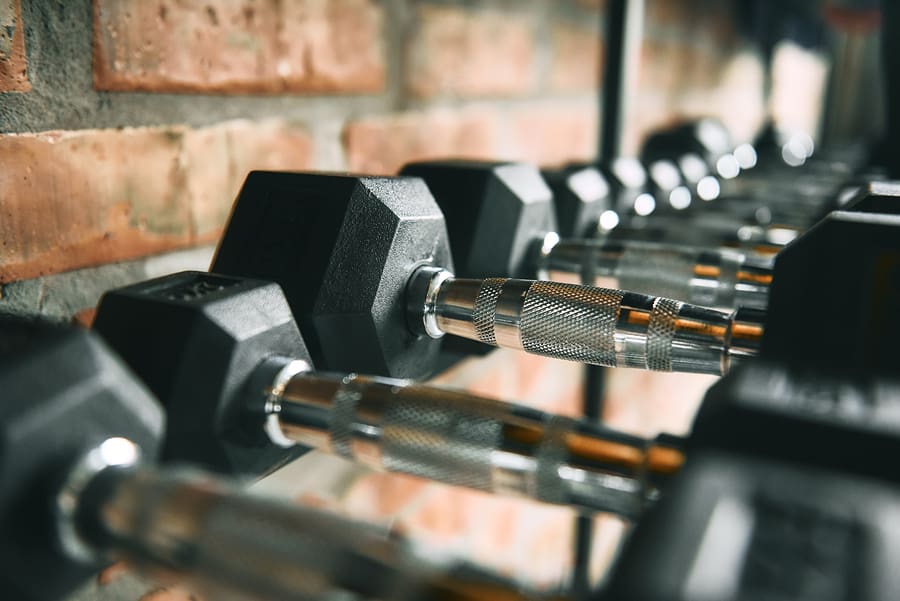
The most traditional example of free weights is dumbbells. But technically anything not attached to another piece of equipment can be considered a free weight. So barbells, kettlebells (which we’ll get to in a second), weighted balls, sandbags, etc. are also considered free weights.
We’ll focus mostly on dumbbells in this section because they can be more approachable than other types of workout equipment. Because of this, you’ll also find many people using them improperly.
Dumbbells are very versatile for performing isolated or combo strength movements. An example of an isolated movement is a bicep curl. An example of a combo movement is a lunge with a bicep curl. Dumbbells can be used to perform upper body, lower body, and core exercises for a total body workout.
Weighted balls and sandbags are for performing more dynamic combo activities.
Dumbbell pros
- Dumbbells allow you to move in comfortable ranges.
- They offer many weight options and provide total body workout options.
- Able to perform isolation or compound exercises.
- They can easily be incorporated into group fitness classes and accommodate many fitness levels with the lowest weights starting around 1-2 pounds.
- Dumbbells are reasonably inexpensive if buying for a home gym.
Dumbbell cons
Free weights are precisely that, free. They are not attached to any other tracks or equipment that might help keep you in alignment. This alone is not a con; however, form is crucial when working with free weights because there is a lot of room for error.
Form needs to be on point to avoid injury. Momentum is not your friend! Slow and controlled movements are encouraged to build strength and avoid injury.
Related read: Game Changing Workout Equipment For Small Spaces
Kettlebells

Kettlebells (friendly PSA: not kettle-BALL) are the new kids on the block, at least to mainstream gyms.
Everything old is new again, with a modern spin. Kettlebells have roots in 19th-century Russian weight training, and some say an ancestor of the kettlebell existed in ancient Greece. Apparently, people have been swinging around weights for centuries.
While I can’t vouch for the ancient Greeks, let’s get real; nowadays, people like them because they look cool.
Are they interchangeable with dumbbells? Not exactly. Let’s explore.
How kettlebells differ from dumbbells
The idea of kettlebell training as a workout offers different perks than your straight-up weight training. Because of the handle on top, they can be used for more dynamic movements.
The center of mass of a kettlebell is outside of your grip, versus a dumbbell where it’s distributed evenly throughout the grip. This isn’t better or worse. Its shape lends itself to specific movements, for example, the traditional kettlebell swing.
Research is mixed; however, some studies suggest kettlebell workouts provide additional cardio, endurance, and muscular power as benefits over more traditional methods of weight training.
While there is some overlap with dumbbell exercises as far as what movements you can do, kettlebell exercises can be very different. You should never go pick up a kettlebell and start swinging it around without proper instruction.
Performing kettlebell movements requires more stabilization and uses momentum, which is usually something to avoid with strength training.
Again, different apparatus, different goals.
If you’re interested in learning how to use kettlebells, you should get proper instruction from someone who is trained specifically in kettlebells.
Kettlebell pros
Some traditional free weight exercises can be performed, and the kettlebell shape may be more comfortable to hold (example: free weight deadlift or overhead triceps extension).
The overall design of the kettlebell lends itself to compound movements for a higher level of functional training and kettlebell specific exercises.
Kettlebells are small enough to add a few different sizes to your home gym.
Kettlebell cons
Kettlebells are not recommended for absolute beginners or those who have difficulty with body awareness and coordinated movements due to a higher risk for injury.
It is not recommended to perform kettlebell exercises to failure due to the dynamic nature of the movements.
Kettlebells have a steeper learning curve than traditional free weights.
Weight machines
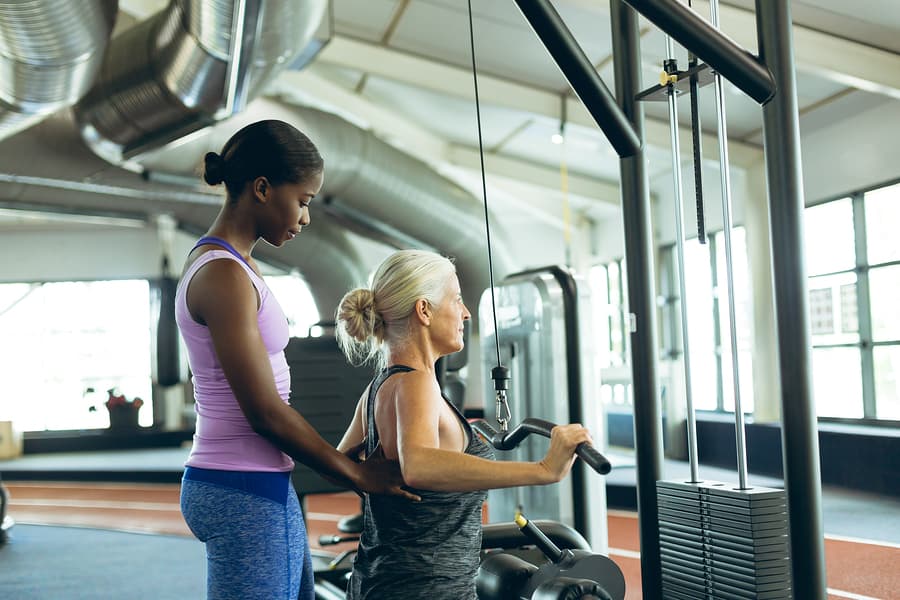
Weight machines isolate specific muscle groups. Examples of common types of weight machines are lat pulldown, seated row, hamstring curl, leg press, and chest press, to name a few.
There are many types of weight machines but each is somewhat of a one trick pony compared to some other types of strength training equipment. All you can do at a chest press machine is a chest press. Free weights allow you to do many different exercises with the same set.
Weight machines may slightly vary in appearance, depending on the manufacturer. However, if you know how to use one chest press machine, you should easily be able to figure out another.
Many have directions on the machine detailing which muscle groups are targeted and how to use the equipment, making them appealing to beginners.
Weights are adjusted by pulling/placing a pin in the weight stack. You can add extra small weights to accommodate more options if you’re not ready to bump up to the next available weight on the stack.
Other machines may require that you manually load plates onto them.
Weight machine pros
Weight machines can assist with proper alignment, making them somewhat easier for beginners, or those who have difficulty monitoring their form.
They accommodate heavier weight options and isolate specific muscle groups.
Weight machine cons
While they might seem easier to use, you can still hurt yourself.
These machines take up a lot of space, and there may be limited muscle group options if it’s a small facility. You can get stuck only working a few areas if you’re only using machines.
Alignment may not always be optimal. You will need to know how to adjust for your height/available range of motion.
Sitting down and isolating one muscle group at a time lacks the ability to keep your heart rate up.
Some weight machines don’t offer the most functional movements
Example: knee extension machine.
Does it provide some strengthening to the quads? Some.
Do you ever make this motion in your everyday life? No. Therefore, it doesn’t directly translate into functional movement.
I’m not saying to never use this machine, but don’t make it the only quad strengthening exercise you do. It’s fine as a piece of an overall program.
Option: closed chain leg press or bodyweight squat.
Does this provide strengthening to the quads? Yes, as well as other lower body muscle groups at the same time.
Do you ever make this motion in life? Yes, like every time you get up from a chair or bend down to pick something up.
Functional exercises strengthen movements we do during everyday life.
Cable machines

These are many-in-one type machines. Some single weight machines may use a cable system, but this section is about multi-function cable machines.
They can be adjusted to perform a variety of exercises and have a cable hooked up to a pulley and weight stack to adjust the resistance, typically starting around 5-10 pounds.
Examples of cable machine exercises include cross over pulls, rows, diagonal chops, and triceps extension.
Cable machine pros
- Accommodates many levels of fitness; however, not all movements are ideal for beginners.
- You can perform more functional exercises than single weight machines, and they feature interchangeable handles and grips for comfort.
Cable machine cons
- Adjusting the machine for each type of exercise can be time-consuming.
- There can be a lot of moving parts, deterring some from learning to use the machine.
- There’s nothing keeping you in proper alignment so form is all up to you.
Barbells
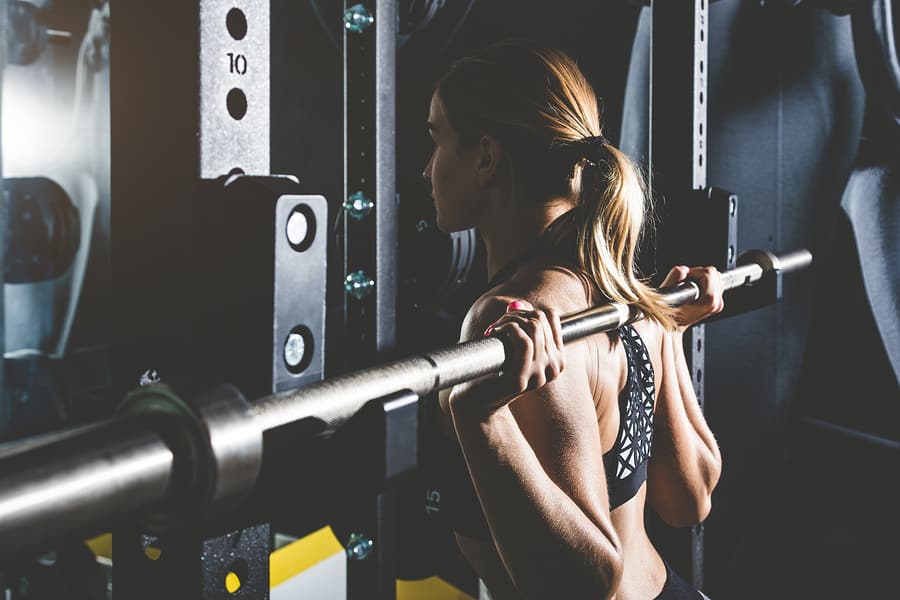
You can find barbells in all shapes and sizes all over the gym. One place you’ll definitely see them is at the squat rack.
Barbells can be used for a variety of exercises as well as accommodate heavy lifting.
Some people may just be using the bar (a standard barbell weighs 45 pounds) to perform exercises, or you can add weight plates to increase the challenge.
It’s important to note, this area of the gym is not just for men. Anyone can use these weights as long as you know what you’re doing. More women than ever are using barbells as part of a strength training routine.
For a more in-depth look into this type of equipment, including a great breakdown between a Smith Machine (which has a bar fixed on a track) and a squat rack, this website can be a great resource.
Barbell pros
- Always the option to just use the bar.
- Some gyms have lighter training barbells available.
- Squat racks allow for heavier weights and a variety of functional exercises.
- Barbells come in multiple shapes to accommodate different exercises.
- Smaller barbells with a fixed weight can be found around the gym if the idea of a squat rack doesn’t interest you.
Barbell cons
The standard barbell weighs 45 pounds making it not ideal for absolute beginners. Beginners will need to work up to this weight and get proper instruction on form and how to use equipment safely.
There is more room for error and injury with heavier weights.
Barbells focus on large muscle groups. If you have weakness in smaller stabilizer muscles you will also need to train these groups in other ways to avoid injury.
Resistance bands

If you’ve ever been to physical therapy, you know we love us some resistance bands. But they’re not just for rehab; they’re great for regular strengthening too!
They come in a variety of strengths (colors will vary by brand) and can be very useful for posture exercises and as a band around the knees to perform hip abduction exercises.
Resistance band pros
- Resistance bands are lightweight, don’t take up a lot of space, come in a variety of strengths.
- They are inexpensive to invest in a home program or to incorporate into a group fitness class.
Resistance band cons
- They don’t last forever and can snap, make sure to inspect the band for signs of wear.
- While you can rig up a band to do many exercises, there’s some assembly required, and other types of weights may offer a better option.
- Beginners may find it difficult to control the path of the band which results in poor form.
Suspension trainers
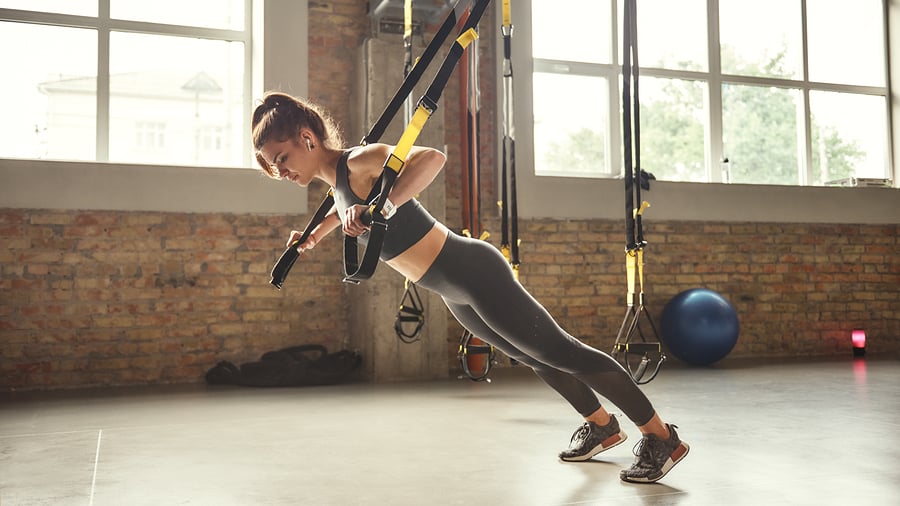
Suspension trainers are a form of bodyweight resistance training. Exercises are performed with straps fixed to an anchor. TRX is a popular brand.
It’s easy to vary the difficulty by adjusting the angle of your body. Suspension trainers can assist with promoting good form for moves like squats and lunges.
Since this is a newer piece of equipment, research is limited. This study showed similar gains in strength, power, movement, and jumping between suspension training and traditional resistance training.
Suspension trainer pros
- Multi-function and doesn’t take up a lot of space.
- Provides a full-body workout including some higher-level options for core strengthening.
- Easy to adjust the difficulty by changing the angle of your body.
- Accommodates many fitness levels.
Suspension trainer cons
While it can offer a full-body workout, most people are not familiar with how to do this and as a result, can get stuck doing the same 3-4 exercises over and over again. Squats, lunges, push-ups, and rows are the popular ones.
Resistance can be limited compared to other strength training equipment. It depends on your level and what your goals are.
Instability provides a unique challenge but may be too advanced for beginners with some exercises.
General guidelines for strength training
- Get to know the weight training equipment you’re using so you can adjust it properly to fit your needs.
- Always use proper form with slow and controlled movements to avoid injury. Make sure you know the basics before adding weight.
- Don’t use equipment for other than what it’s designed for.
- Select a weight that’s challenging but that you can still complete 8-12 reps with good form. Once your form begins to breakdown, the risk of injury rises significantly.
- Pay attention to your breathing and match your breath to the work. Exhale when working against the resistance and inhale when you release.
- Work the body evenly. We all have our favorite moves, but neglecting a muscle group can lead to imbalances and issues down the road.
- Give yourself time to recover.
- If you’re totally new, consider a few sessions with a personal trainer to design a program for you and teach proper form as well as how to adjust strength training equipment.
- Change up your routine periodically and consider using different types of strength training equipment.
What’s the best strength training equipment?
Well, that depends on you, what your goals are, injuries, and your ability to monitor yourself and use equipment safely.
There’s no one size fits all to strength training, and that’s part of what makes it so great. If you’re not sure what’s best for you, you can always work with a certified personal trainer to design a program and teach you proper form.
A different mix of strength training equipment will offer options to get the most from weight training. Each piece of equipment offers something unique to the workout. Your ratio is up to you and what works with your body.
Featured image credit: copyright Maridav / bigstockphoto.com
References & Resources
ACSM Guidelines for Resistance Training
José Luis Maté-Muñoz, Antonio J. Antón Monroy, Pablo Jodra Jiménez, Manuel V. Garnacho-Castaño. (2014) Effects of Instability Versus Traditional Resistance Training on Strength, Power and Velocity in Untrained Men. Journal of Sports Science and Medicine(13), 460 – 468.
Mortara A, Michael A D, Kaitlynn E R. A Review of Kettlebell Research and its Implications for Exercise Programming. Res Inves Sports Med. 1(2). RISM.000510: 2017. DOI: 10.31031/RISM.2017.01.000510
Otto, William & Coburn, Jared & Brown, Lee & Spiering, Barry. (2012). Effects of Weightlifting vs. Kettlebell Training on Vertical Jump, Strength, and Body Composition. Journal of Strength and Conditioning Research / National Strength & Conditioning Association. 26. 1199-202. 10.1519/JSC.0b013e31824f233e
Schreiber,
Brett, “Physiological Effects of a Kettlebell Workout versus a
High-Resistance Circuit Workout” (2014). Theses and Dissertations. 2152.
http://scholarworks.uark.edu/etd/2152

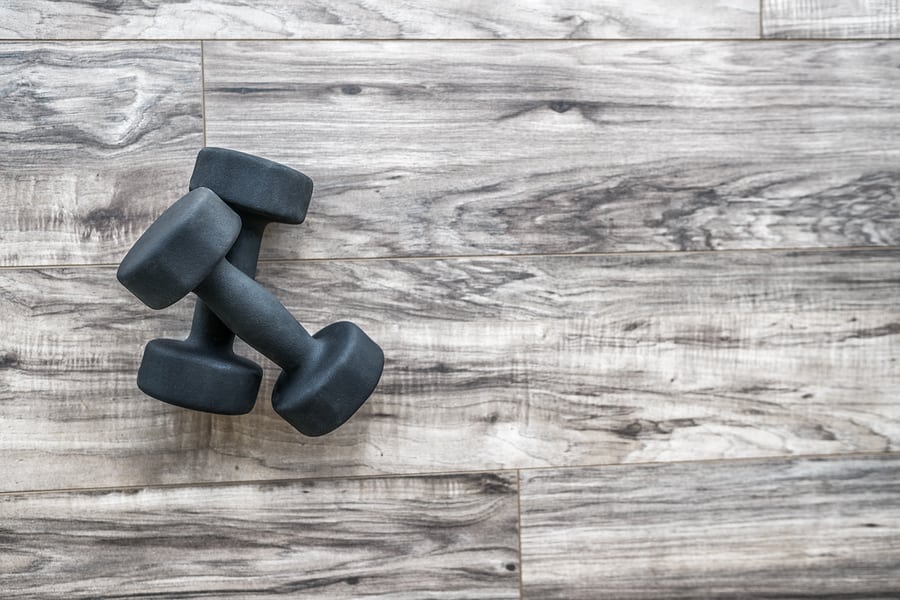
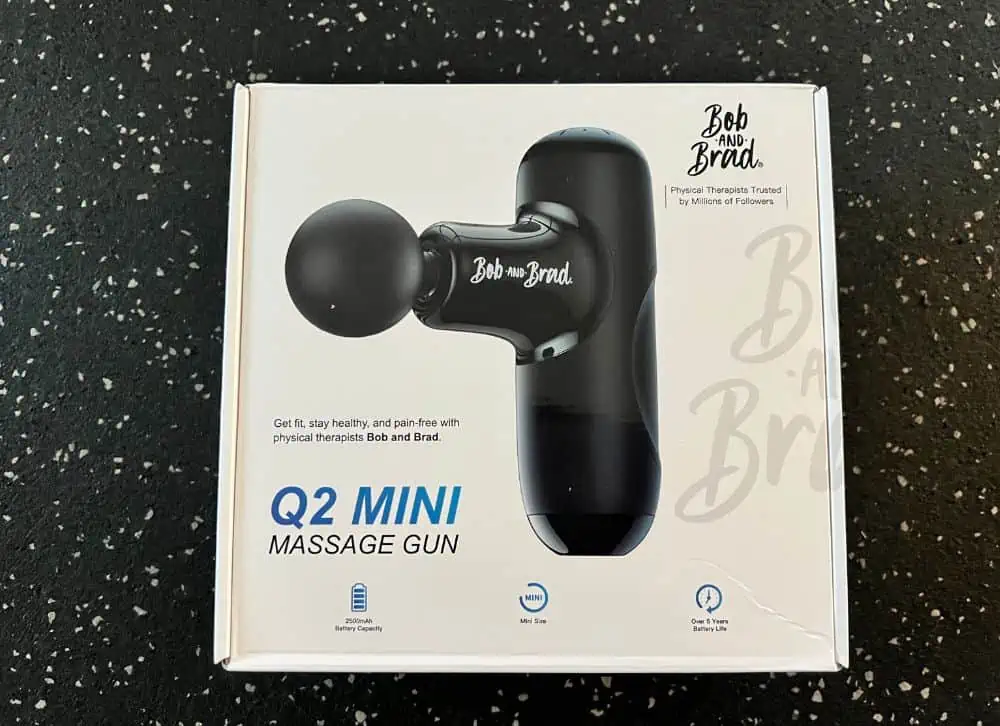


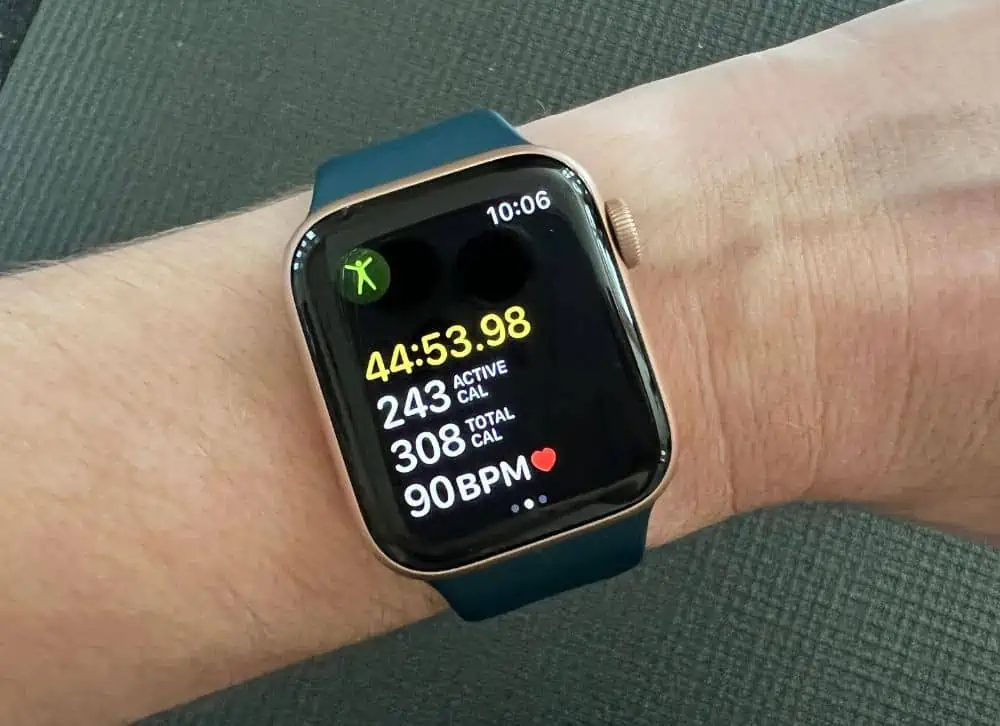
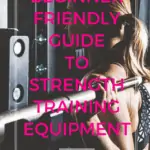
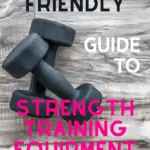
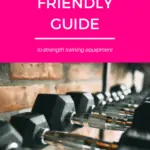
Where I swim, the facility has a slew of machines about which I know nothing. So, sure, I will occasionally use the treadmill, the stationary bike, the rowing machine… but I avoid the rest. Thanks for the introduction to some of them.
Love these tips! I’m trying to commit to a new at-home workout routine in 2020 and this post will come in handy for sure! Thanks for sharing 🙂
Thank you, glad you enjoyed.
One thing I was told is to be sure to slow down the exercise and follow through completely. So many new people, myself included, try to go too heavy and have a hard time extending fully and go too fast. A tricep kickback, for instance, needs full slow extension all the way back and then slow to finish… feeling the motions. Helps to count 1, 2 back and 3 4 to finish.
Hey,
I’m not a personal trainer, but I prefer weights to aerobic. I like to feel it and I’ve been working out a while. I try to pick up tips for myself all over and one thing I see all the time and I’m sure I’ve done it too is going too fast on the excercise. So many new people try to add too much weight too soon when the most important thing is to be able to fully extend the exercise and go slow. Someone told me count it out. For instance on a tricep kickback, 1 2 back and 3 4 back to beginning, extending back fully. If you go fast, the excercise is only half done and the benefits are way less. Is this correct?
Counting is a great way to slow down movements and there are many different counts depending on what the goal of the strengthening is. Poor form (including going too fast and using momentum) + too much weight increases risk of injury. Thanks for reading!
I love all this info. Resistance bands are great. But I would love to try the suspension trainers
Great article Maura!
Happy Thanksgiving to you and your family ?
Great advice! Thanks for sharing this!